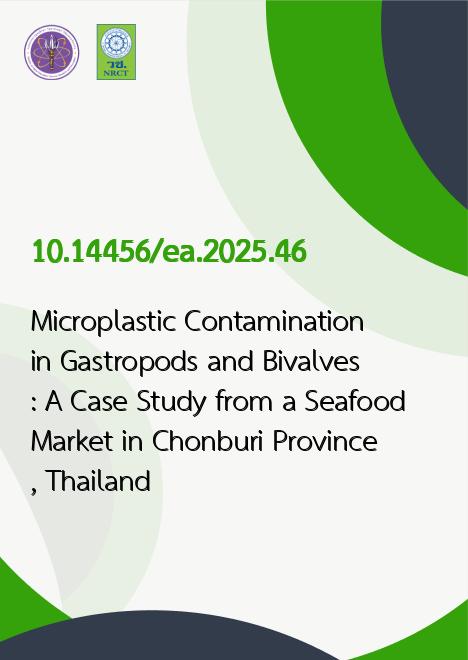
|
Microplastic Contamination in Gastropods and Bivalves: A Case Study from a Seafood Market in Chonburi Province, Thailand |
|---|---|
| รหัสดีโอไอ | |
| Creator | Nittaya Pasukphun |
| Title | Microplastic Contamination in Gastropods and Bivalves: A Case Study from a Seafood Market in Chonburi Province, Thailand |
| Contributor | Manaporn Wongsoonthornchai, Pornnapa Saelee, Nittaya Pasukphun |
| Publisher | Thai Society of Higher Education Institutes on Environment |
| Publication Year | 2568 |
| Journal Title | EnvironmentAsia |
| Journal Vol. | 18 |
| Journal No. | 3 |
| Page no. | 1-14 |
| Keyword | Contamination, Exposure assessment, Seafood market, Microplastics, Gastropods, Bivalves |
| URL Website | http://www.tshe.org/ea/index.html |
| Website title | EnvironmentAsia |
| ISSN | 1906-1714 |
| Abstract | This study investigated microplastic contamination in gastropods and bivalves sold at a majorseafood market in Chonburi Province, Thailand. Microplastic levels were 6.5 ± 3.20 pieces/gramor 35.93 ± 13.40 pieces/individual in gastropods and 6.90 ± 3.48 pieces/gram or 31.25 ± 22.85pieces/individual in bivalves, with oysters showing the highest contamination, followed bygreen mussels and spotted Babylon snails. The average microplastic size was 0.24 ± 0.35 mmin gastropods and 0.67 ± 0.86 mm in bivalves. Most microplastics in gastropods were fragmentsat 57.14% and fibers at 42.68%. The predominant color was black at 33.33%, followed bywhite at 22.22%, with blue, brown, red, and translucent at 11.11% each. Gastropods containedPolyetherimide (PEI) and Polyethylene terephthalate (PET) equally at 50%, while bivalveshad Polyethylene (PE) at 33.33%, Styrene acrylonitrile (SAN) and Teflon (PTFE) at 22.22%each, and PET and Polystyrene (PS) at 11.11% each. Consumers aged 18 – 34.9 years hadthe highest exposure, with an average of 6.63 pieces/person/day or 2,420.86 pieces/person/year.Cockles and green mussels reached hazard level 5 due to SAN contamination. This studyrevealed significant microplastic contamination and provided key insights for government andprivate sectors for future surveillance measures. |